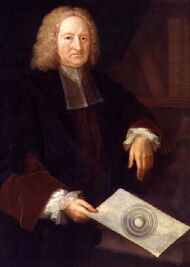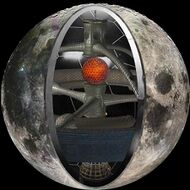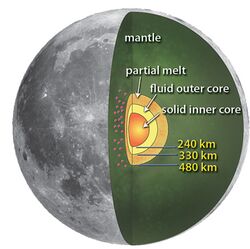Astronomy:Hollow Moon
The Hollow Moon hypothesis, or Spaceship Moon hypothesis, proposes that Earth's Moon is either wholly hollow or otherwise contains a substantial interior space. No scientific evidence exists to support the idea; seismic observations and other data collected since spacecraft began to orbit or land on the Moon indicate that it has a thin crust, extensive mantle and small, dense core, although overall it is much less dense than Earth.
The Hollow Moon concept is similar to the better-known Hollow Earth hypothesis, which was a recurring plot device in pre-spaceflight science fiction. The first discussion of a hollow Earth was by scientist Edmond Halley in 1692, with the first mention of a hollow Moon being in H. G. Wells' 1901 novel The First Men in the Moon.
Introduction

The Hollow Moon hypothesis is the suggestion that the Moon is hollow, usually as a product of an alien civilization.[1][2] It is often called the Spaceship Moon hypothesis,[1][2] and often corresponds with beliefs in UFOs or ancient astronauts.[2][3]
The suggestion of a hollow moon first appeared in science fiction, when H. G. Wells wrote about a hollow moon in his 1901 book The First Men in the Moon.[1][4] The concept of hollow planets was not new; Wells borrowed from earlier fictional works that described a hollow Earth, such as the 1741 novel Niels Klim's Underground Travels by Ludvig Holberg.[5] Academic proposals for a hollow Earth pre-dated that. Edmond Halley's hypotheses, advanced in 1692,[6] was the first one to specify an actual void in the Earth.[7]
Greek mythology, with its Hades, and early religious concepts of an underworld, such as the Christian Hell, contributed to ideas of the Earth being hollow.[8]
It is now considered to be a fringe theory.[9] It is often described in the media as a conspiracy theory,[1][10][11] and the concept of the Moon as a spaceship is often mentioned as one of David Icke's beliefs.[10][12][13]
Claims and rebuttals

Vasin-Shcherbakov
In 1970, Michael Vasin and Alexander Shcherbakov, of what was then the Soviet Academy of Sciences, advanced a hypothesis that the Moon is a spaceship created by unknown beings.[2] The article was entitled "Is the Moon the Creation of Alien Intelligence?", and was published in Sputnik,[10] the Soviet equivalent of Reader's Digest.[1][14]
Their hypothesis relies heavily on the suggestion that large lunar craters, generally assumed to be formed from meteor impact, are generally too shallow and have flat or even convex bottoms. They hypothesized that small meteors are making a cup-shaped depression in the rocky surface of the moon while the larger meteors are drilling through a rocky layer and hitting an armoured hull underneath.[15]
The authors reference earlier speculation by astrophysicist Iosif Shklovsky, who suggested that the Martian moon Phobos was an artificial satellite and hollow; this has since been shown to not be the case. Sceptical author Jason Colavito points out that all of their evidence is circumstantial, and that in the 1960s the atheistic Soviet Union promoted the ancient astronaut concept in an attempt to undermine the West's faith in religion.[2]
The Moon rang like a bell
Between 1972 and 1977, seismometers installed on the Moon by the Apollo missions recorded moonquakes. The Moon was described as "ringing like a bell" during some of those quakes, specifically the shallow ones.[16] This phrase was brought to popular attention in March 1970,[1] in an article in Popular Science.[17] When Apollo 12 deliberately crashed the Ascent Stage of its Lunar Module onto the Moon's surface, it was claimed that the Moon rang like a bell for an hour, leading to arguments that it must be hollow like a bell.[1] Lunar seismology experiments since then have shown that the lunar body has shallow moonquakes that act differently from quakes on Earth, due to differences in texture, type and density of the planetary strata, but there is no evidence of any large empty space inside the body.[16]
Density
The fact that the Moon is less dense than the Earth is advanced as support for it to be hollow. The moon's mean density is 3.3 g/cm3 whereas the Earth's is 5.5 g/cm3.[15] One explanation of this discrepancy is that the moon may have been formed by a giant impact which ejected some of the early Earth's upper crust into its orbit.[4][18] The Earth's upper mantle and crust are less dense than its core.[19]
Scientific perspective

Cornell University's Ask an Astronomer, run by volunteers in the Astronomy Department,[20] answered the question "Can we prove that the Moon isn't hollow?". There, physicist Suniti Karunatillake suggests that there are at least two ways to determine the distribution of mass within a body. One involves moment of inertia parameters, the other involves seismic observations. In the case of the former, Karunatillake points out that the moment of inertia parameters indicate that the core of the moon is both dense and small, with the rest of the moon consisting of material with nearly-constant density. As for the latter, he notes that the moon is the only planetary body besides Earth on which extensive seismic observations have been made. These observations have constrained the thickness of the moon's crust, mantle and core, suggesting it could not be hollow.[21]
Mainstream scientific opinion on the internal structure of the Moon overwhelmingly supports a solid internal structure with a thin crust, an extensive mantle and a small denser core.[22][23] This is based on:
- Seismic observations. Besides Earth, the Moon is the only planetary body with a seismic observation network in place. Analysis of lunar seismic data have helped constrain the thickness of the crust (~45 km)[23][24] and mantle, as well as the core radius (~330 km).[22]
- Moment of inertia parameters. For the Moon, moment of inertia parameters have demonstrated that the core is ~1.4% of the total mass.[25] One such parameter, the normalized polar moment of inertia, is 0.393 ± 0.001.[25][26] This is very close to the value for a solid object with radially constant density, which would be 0.4 (for comparison, Earth's value is 0.33).[25] The normalized polar moment of inertia for a hollow Moon would have a higher value, closer to 0.67.[27]
- Fine-scale variation (e.g. variation along the orbit of the Lunar Prospector orbiter) of the lunar gravitational field, which is consistent with geologic processes involving a crust, mantle, and core.[25]
In literature
- H.G. Wells, The First Men in The Moon (1901). Wells describes fictional insectoids who live inside a hollow Moon.[4][28]
- Edgar Rice Burroughs, The Moon Maid (1926). A fantasy story set in the interior of a postulated hollow Moon which had an atmosphere and was inhabited.[4][29]
- Nikolay Nosov, Dunno on the Moon (1965). A Russian fairytale novel with a hollow Moon.[30]
- Isaac Asimov, Foundation and Earth (1986). Science fiction in which robot R. Daneel Olivaw is depicted living inside a partially hollow Moon.[31]
- David Weber, Empire from the Ashes (2003). Science fiction in which the Moon is a giant spaceship which arrived 50,000 years ago.[32]
- Christopher Knight & Alan Butler, Who Built the Moon? (2005). They suggest humans from the future travelled into the past to build the Moon in order to safeguard human evolution.[33]
- David Icke, Human Race Get off Your Knees – The Lion Sleeps No More (2010). Icke suggests that the Moon is in fact a space station from which Reptilians manipulate human thought.[34]
References
- ↑ 1.0 1.1 1.2 1.3 1.4 1.5 1.6 "Is the Moon Hollow?". Armagh Planetarium. 22 May 2015. http://www.armaghplanet.com/blog/is-the-moon-hollow.html.
- ↑ 2.0 2.1 2.2 2.3 2.4 ""Spaceship Moon" and Soviet Scientific Politics". JasonColavito.com. 23 September 2012. http://www.jasoncolavito.com/blog/spaceship-moon-and-soviet-scientific-politics.
- ↑ "Space Station Moon". Ancient Aliens. History Channel. S11, E11. http://www.history.com/shows/ancient-aliens/season-11/episode-11.
- ↑ 4.0 4.1 4.2 4.3 "Hollow Moon". Solar System Exploration Research Virtual Institute. 2 February 2009. http://sservi.nasa.gov/?question=hollow-moon.
- ↑ Jerome Hamilton Buckley, ed (1975). The Worlds of Victorian Fiction. Harvard University Press. p. 412, n. 27. ISBN 9780674962057. https://books.google.co.nz/books?id=C-15i-FdHOIC&pg=PA412#v=onepage&q&f=false.
- ↑ "An Account of the cause of the Change of the Variation of the Magnetic Needle; with an Hypothesis of the Structure of the Internal Parts of the Earth". Philosophical Transactions of the Royal Society of London III: pp. 470-78, esp. p. 475. 1683–1694. doi:10.1098/rstl.1686.0107. https://archive.org/stream/philosophicaltra03royarich#page/474/mode/2up.
- ↑ N. Kollerstrom (1992). "The Hollow World of Edmond Halley". Journal for the History of Astronomy 23: 185–92. doi:10.1177/002182869202300304. Bibcode: 1992JHA....23..185K. http://dioi.org/kn/halleyhollow.htm.
- ↑ Brian Regal (2009). Pseudoscience: A Critical Encyclopedia. Greenwood Press. p. 81. ISBN 9780313355080. https://books.google.co.nz/books?id=c6PACQAAQBAJ&pg=PA81#v=onepage&q&f=false.
- ↑ Although not described as such by the media, it is more accurately a fringe theory than a conspiracy theory.
- ↑ 10.0 10.1 10.2 "The Moon Is An Alien UFO Spaceship Parked In Orbit Around Earth, Conspiracy Theorist David Icke Says [Video"]. Inquisitr. 28 May 2016. http://www.inquisitr.com/3142772/the-moon-is-an-alien-ufo-spaceship-parked-in-orbit-around-earth-conspiracy-theorist-david-icke-says-video/.
- ↑ "'Hollow Moon that rings like a bell put into orbit by ancient ALIENS', shock theory claims". The Daily Express. 23 February 2017. http://www.express.co.uk/news/weird/771246/Hollow-Moon-theory-aliens.
- ↑ "Taking tea with David Icke, the world's best-known conspiracy theorist". The Sydney Morning Herald. 16 July 2016. http://www.smh.com.au/nsw/taking-tea-with-david-icke-the-worlds-bestknown-conspiracy-theorist-20160715-gq6poq.html.
- ↑ "Mocked prophet: what is David Icke's appeal?". New Humanist. 10 December 2014. https://newhumanist.org.uk/articles/4797/mocked-prophet-what-is-david-ickes-appeal.
- ↑ Dominic Phelan, ed (2013). Cold War Space Sleuths. Springer-Praxis. p. 34. ISBN 9781461430520. https://books.google.co.nz/books?id=s3iukQc_DBEC&pg=PA34#v=onepage&q&f=false.
- ↑ 15.0 15.1 "Our Moon Is An Alien UFO Spaceship Parked In Orbit Around Earth, UFOlogists Claim". Inquisitr. 12 March 2015. http://www.inquisitr.com/1917650/our-moon-is-an-alien-ufo-spaceship-parked-in-orbit-around-earth-ufologists-claim/.
- ↑ 16.0 16.1 "Moonquakes". NASA. 15 March 2006. http://www.nasa.gov/exploration/home/15mar_moonquakes.html.
- ↑ Wernher von Braun (March 1970). "How APOLLO 13 Will Probe The Moon's Interior". Popular Science. https://books.google.ie/books?id=6QAAAAAAMBAJ&pg=PA57#v=onepage&q&f=true.
- ↑ "Why Do We Have a Two-Faced Moon?". Bad Astronomer. 1 July 2014. http://www.slate.com/blogs/bad_astronomy/2014/07/01/the_moon_s_two_faces_why_are_they_so_different.html.
- ↑ Cain, Fraser (3 November 2008). "Density of the Moon". http://www.universetoday.com/20601/density-of-the-moon/. Retrieved 21 November 2016.
- ↑ "About the Ask an Astronomer Team". Ask an Astronomer. Cornell University. 14 November 2011. Archived from the original on 4 February 2015. https://web.archive.org/web/20150204133449/http://curious.astro.cornell.edu/aboutus.php.
- ↑ "Can we prove that the Moon isn't hollow?". Ask an Astronomer. Cornell University. October 2007. Archived from the original on 2008-04-22. https://web.archive.org/web/20080422063519/http://curious.astro.cornell.edu/question.php?number=738.
- ↑ 22.0 22.1 "NASA Research Team Reveals Moon Has Earth-Like Core". NASA. 6 January 2011. http://www.nasa.gov/topics/moonmars/features/lunar_core.html.
- ↑ 23.0 23.1 Mark Wieczorek and 15 coauthors (2006). "The constitution and structure of the lunar interior". Reviews in Mineralogy and Geochemistry 60: 221–364. doi:10.2138/rmg.2006.60.3. Bibcode: 2006RvMG...60..221W. Archived from the original on 2014-12-21. https://web.archive.org/web/20141221063318/http://scripts.mit.edu/~paleomag/articles/60_03_Wieczorek_etal.pdf.
- ↑ A. Khan; K. Mosegaard (2002). "An inquiry into the lunar interior: A nonlinear inversion of the Apollo lunar seismic data". Journal of Geophysical Research 107 (E6): 5036. doi:10.1029/2001JE001658. ISSN 0148-0227. Bibcode: 2002JGRE..107.5036K. http://onlinelibrary.wiley.com/doi/10.1029/2001JE001658/full.
- ↑ 25.0 25.1 25.2 25.3 AS Konopliv; AB Binder; LL Hood; AB Kucinskas; WL Sjogren; JG Williams (1998). "Improved Gravity Field of the Moon from Lunar Prospector". Science 281 (5382): 1476–80. doi:10.1126/science.281.5382.1476. PMID 9727968. Bibcode: 1998Sci...281.1476K. http://science.sciencemag.org/content/281/5382/1476.full.
- ↑ "Moon Fact Sheet". NASA. 19 April 2016. http://nssdc.gsfc.nasa.gov/planetary/factsheet/moonfact.html.
- ↑ Miriam Riner (December 2008). Compositional Variations in the Inner Solar System (Ph.D.). Arizona State University. p. 3.
- ↑ H.G. Wells (1901). The First Men in The Moon. George Newnes Ltd.. pp. 285–88. https://www.scribd.com/doc/297140811/firstmeninmoon00welluoft?secret_password=CAP6Aul1KgBjdpEdMTCm#fullscreen&from_embed.
- ↑ Edgar Rice Burroughs (1926). "2". The Moon Maid. A. C. McClurg. http://gutenberg.net.au/ebooks06/0601501h.html#chap2.
- ↑ Maria Nikolajeva (2000). From Mythic to Linear: Time in Children's Literature. The Scarecrow Press, Inc.. p. 74. ISBN 9780810849525. https://books.google.co.nz/books?id=WN_6_lfJGqQC&pg=PA74#v=onepage&q&f=false.
- ↑ Donald E. Palumbo (2016). An Asimov Companion. McFarland & Company. p. 123. ISBN 9780786498239. https://books.google.com/?id=ffYWDAAAQBAJ&pg=PA123#v=onepage&q&f=false.
- ↑ "David Weber takes readers on a tour Off Armageddon Reef and discusses writing, religion and responsibility". Sci Fi Weekly. 7 May 2007. Archived from the original on 29 January 2008. https://web.archive.org/web/20080129164620/http://www.scifi.com/sfw/interviews/sfw15625.html.
- ↑ "Peer review: Who Built the Moon?". The Guardian. 1 September 2005. https://www.theguardian.com/science/2005/sep/01/peerreview.
- ↑ David G. Robertson (2016). UFOs, Conspiracy Theories and the New Age: Millennial Conspiracism. Bloomsbury Academic. p. 148. ISBN 9781474253222. https://books.google.co.nz/books?id=4ngwCwAAQBAJ&pg=PT148#v=onepage&q&f=false.

